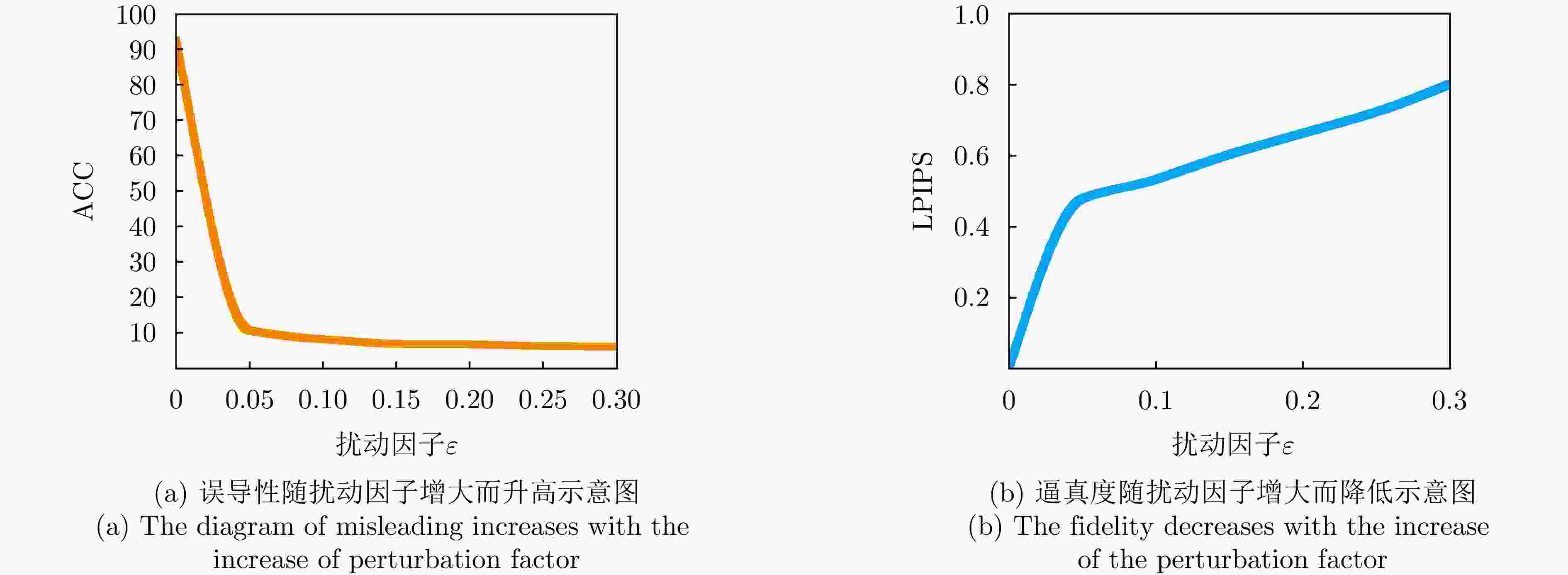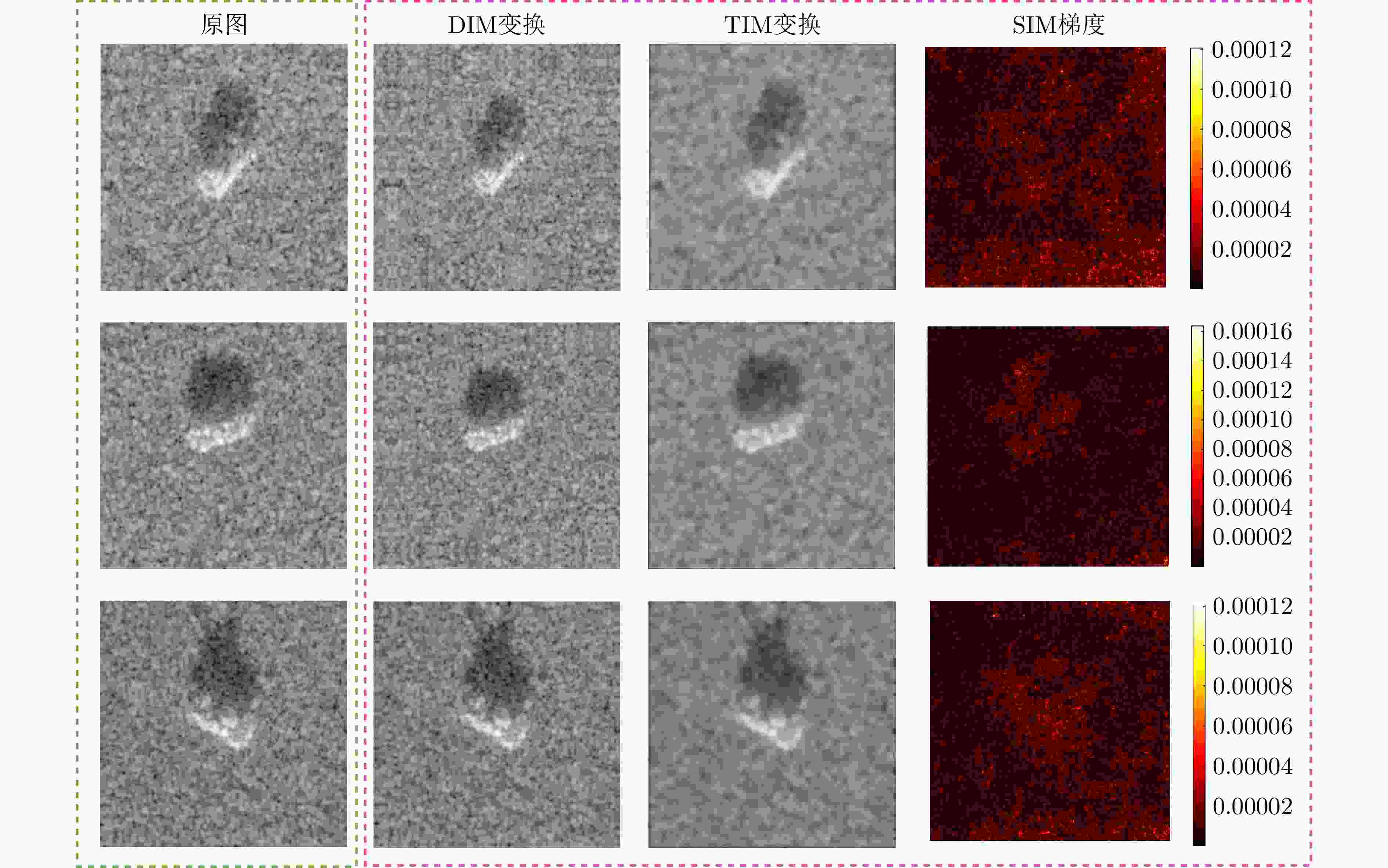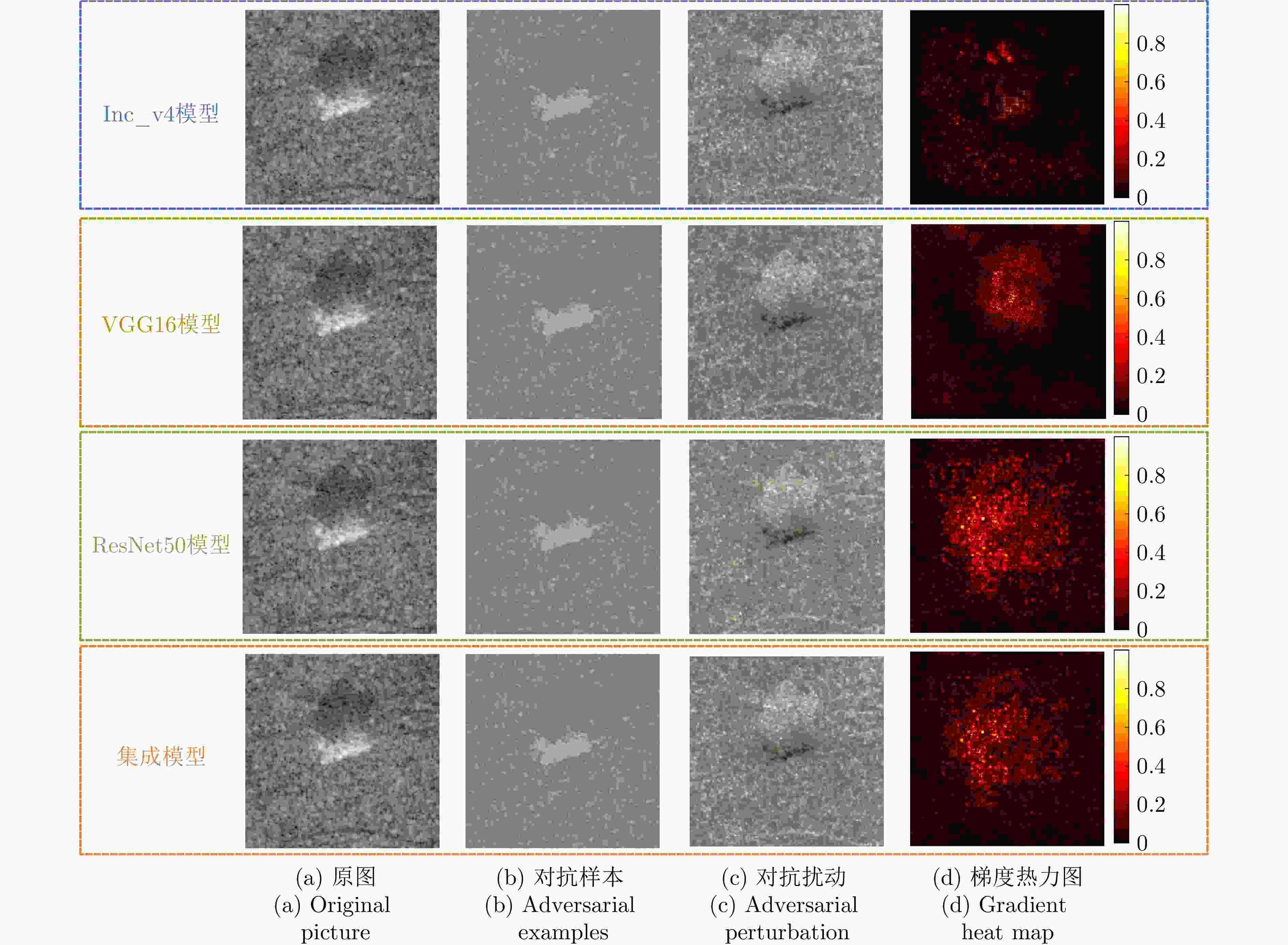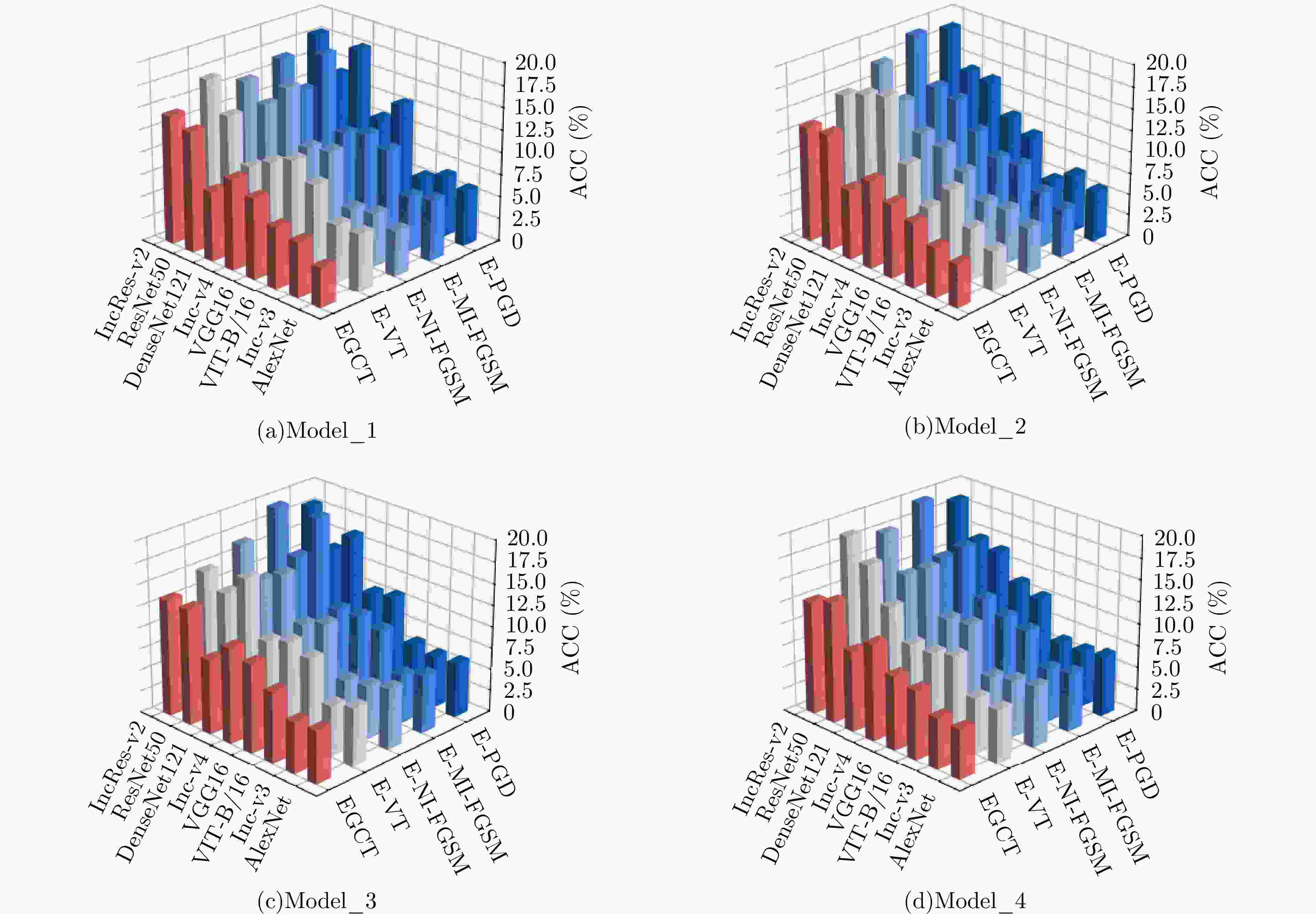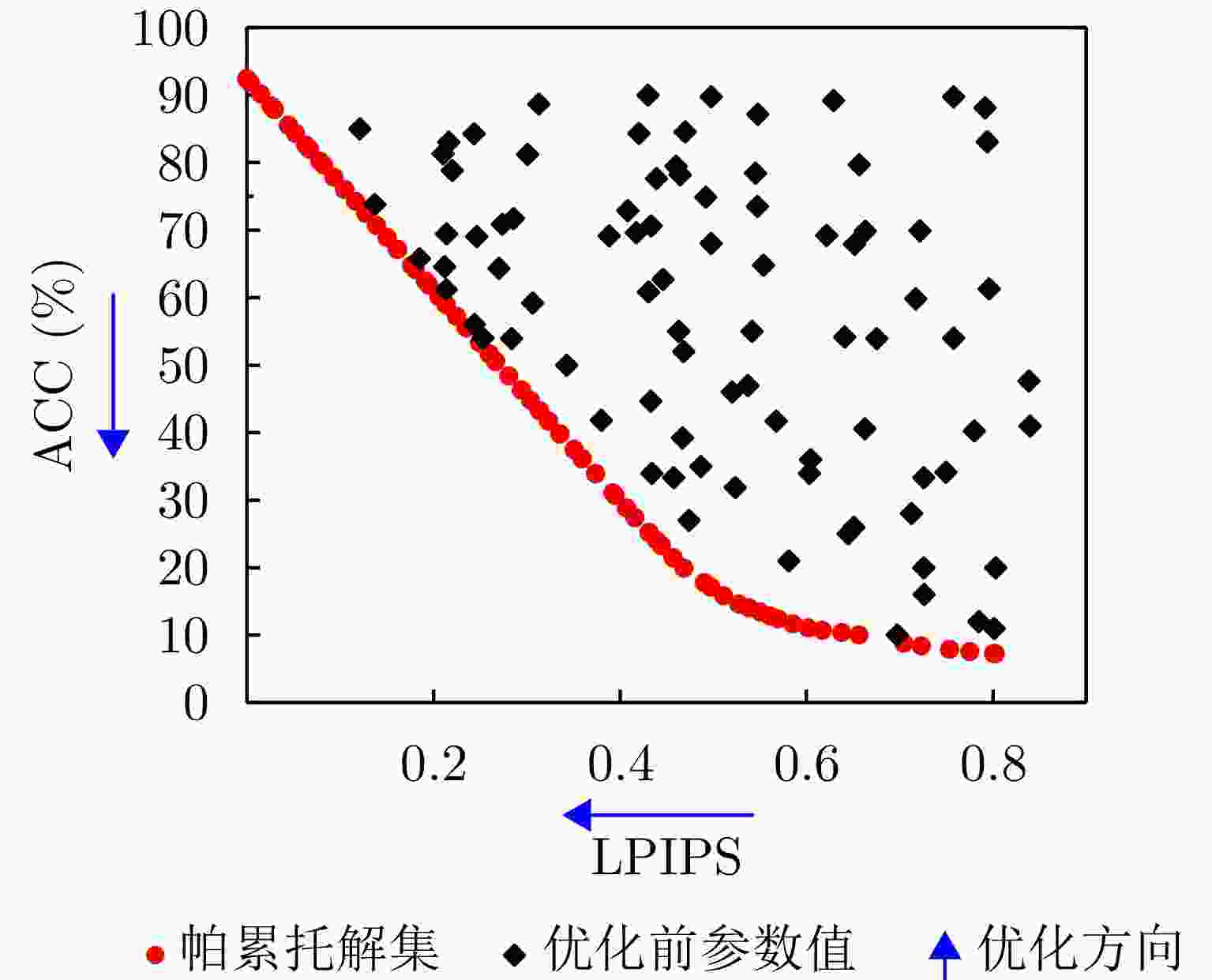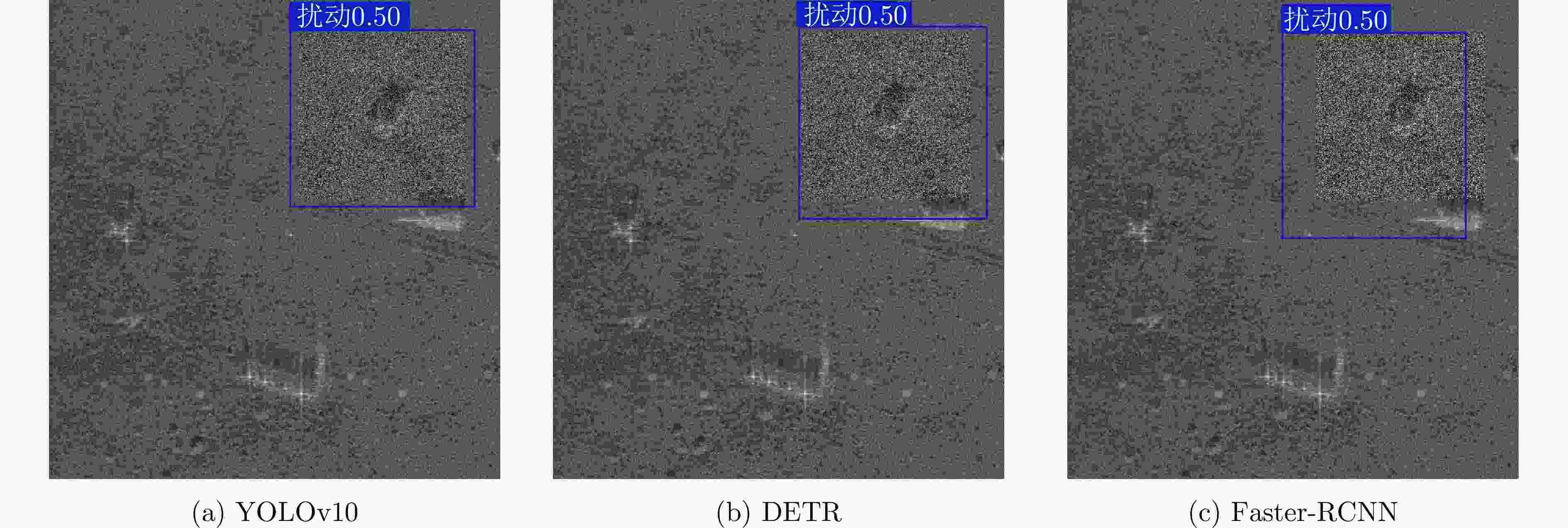Optimal adversarial sample generation method in SAR ATR based on joint misleading and fidelity optimization
-
摘要: 对抗样本生成研究是揭示深度神经网络脆弱性及提升合成孔径雷达自动目标识别(SAR ATR)系统鲁棒性的关键。本文针对对抗样本的误导效能与视觉隐蔽这一核心矛盾的平衡问题,提出了联合误导性与逼真度优化的SAR ATR最优对抗样本生成方法,将对抗样本的生成过程建模为一个以“误导性”和“逼真度”为目标的联合优化问题。本文首先提出了一种集成复合变换攻击法以增强攻击的有效性,并构建了融合目标模型分类准确率(ACC)与学习感知图像块相似度(LPIPS)的联合度量模型以量化两个优化目标。随后,提出一种改进的均匀性引导多目标雾凇算法,通过融合Tent混沌映射、混合动态权重和黄金正弦引导,高效地求解该模型,从而获得一组代表不同权衡程度的帕累托最优解集。最终,利用YOLOv10网络对解集中的样本进行扰动检测,以定位扰动被发现的临界点,实现最优参数的量化。在MSTAR和MiniSAR数据集上的实验表明,所提集成复合变换攻击法针对不同集成模型和分类网络的平均目标模型识别准确率为8.96%,总体误导效果较其他方法平均提升了2.25%,其中复杂模型平均提升5.56%;所提均匀性引导的多目标雾凇算法在解集多样性和收敛速度方面较对比方法提升均超过25%;最终该方法能够在ACC降至28.81%的同时,将LPIPS控制在0.407,扰动因子仅为0.031,实现了误导性与逼真度的最佳平衡。该参数在6种不同防御策略下均能保持有效误导,验证了其强鲁棒性,为SAR ATR领域的对抗攻击研究提供了新的思路与量化基准。
-
关键词:
- 合成孔径雷达自动目标识别 /
- 对抗样本生成 /
- 集成复合变换攻击法 /
- 多目标优化 /
- 均匀性引导多目标雾凇算法
Abstract: Adversarial sample generation is a key research direction for uncovering the vulnerabilities of deep neural networks and improving the robustness of synthetic aperture radar automatic target recognition (SAR ATR) systems. This study proposes an optimal adversarial sample generation method for SAR ATR that jointly optimizes misleading effectiveness and fidelity, aiming to resolve the core contradiction between adversarial effectiveness and visual concealment. The generation process is modeled as a joint optimization problem with the goals of balancing “misleading” and “fidelity.” First, an integrated composite transform attack strategy is designed to enhance attack effectiveness, and a joint measurement model is developed that combines the classification accuracy of the target model with the learned perceptual image patch similarity to quantify the two optimization goals. Next, an improved uniformity-guided multiobjective RIME algorithm is proposed. By integrating the Tent chaotic map, hybrid dynamic weighting, and golden sine guidance, the model is efficiently solved, yielding a set of Pareto-optimal solutions that represent various tradeoff degrees. Finally, the YOLO object detection network is employed to identify perturbations in the samples within the solution set, thereby locating the critical points where disturbances occur and enabling the quantification of optimal parameters. Experiments on MSTAR and MiniSAR datasets show that the proposed ensemble compound transform attack method achieves an average target model recognition accuracy of 8.96% across different ensemble models and classification networks, improving the overall misleading effect by an average of 2.25% compared to other methods. Among them, the complex model increases by an average of 5.56%, while the proposed uniformity-guided multiobjective RIME algorithm improves the solution set diversity and convergence speed by over 25% compared with the comparison method. Using this method, the learned perceptual image patch similarity is maintained at 0.407 and the perturbation factor at 0.031, while classification accuracy decreases to 28.81%, demonstrating a tradeoff between misleading effectiveness and visual fidelity. This parameter maintains effective misleading performance under six different defense strategies, demonstrating strong robustness and providing a new approach and quantitative benchmark for adversarial attack research in SAR ATR. -
表 1 每类数据集样本数
Table 1. Number of samples for each type of data set
目标种类 攻击方数据集A 目标方数据集B MSTAR BMP2 313 312 625 BTR60 226 225 451 T72 309 309 618 T62 286 286 572 BTR70 215 214 429 BRDM2 286 286 572 D7 287 286 573 ZIL131 287 286 573 ZSU234 287 286 573 2S1 286 286 572 表 2 不同优化算法下Pareto解集的参数值
Table 2. Parameter values of Pareto solution set under different optimization algorithms
优化算法 Spacing Spacing误差 运行时间(s) 运行时间误差(s) UMORIME 0.4778 1.6635 18.5102 0.0232 MORIME 0.6198 1.9320 23.7342 0.0298 MOEDO 0.6349 2.0143 23.5368 0.0279 MOCOA 0.6534 2.0459 22.5189 0.0254 MOGOA 0.8541 2.5952 24.2761 0.0319 NSGA-II 2.2300 4.8263 40.1437 0.0750 表 3 不同改进策略有效性对比实验结果
Table 3. Experimental results of effectiveness comparison of different improvement strategies
Tent混沌映射 混合动态权重 黄金正弦引导 Spacing 运行时间(s) × × × 0.6198 23.7342 √ × × 0.5446 23.4121 × √ × 0.5729 21.3463 × × √ 0.5841 21.1359 √ √ × 0.5133 21.1135 √ × √ 0.5142 20.8102 × √ √ 0.5428 19.8576 √ √ √ 0.4778 18.5102 表 4 不同检测网络下最优平衡对抗样本参数值
Table 4. Optimal balanced adversarial sample parameter values under different detection networks
检测网络 LPIPS ACC 扰动因子 Faster R-CNN 0.570 12.37 0.0452 DETR 0.431 25.19 0.0330 YOLOv10 0.407 28.81 0.0310 表 5 不同防御策略下最优平衡对抗样本的参数值
Table 5. The parameter values of the optimal balanced adversarial samples under different defense strategies
防御策略 LPIPS ACC 扰动因子 FGSM 0.469 19.90 0.0369 I-FGSM 0.444 23.25 0.0342 MI-FGSM 0.439 24.05 0.0338 NI-FGSM 0.431 25.19 0.0330 PGD 0.416 27.41 0.0315 VT 0.407 28.81 0.0310 -
[1] 阮航, 崔家豪, 毛秀华, 等. SAR目标识别对抗攻击综述: 从数字域迈向物理域[J]. 雷达学报, 2024, 13(6): 1298–1326. doi: 10.12000/JR24142.RUAN Hang, CUI Jiahao, MAO Xiuhua, et al. A survey of adversarial attacks on SAR target recognition: From digital domain to physical domain[J]. Journal of Radars, 2024, 13(6): 1298–1326. doi: 10.12000/JR24142. [2] 高勋章, 张志伟, 刘梅, 等. 雷达像智能识别对抗研究进展[J]. 雷达学报, 2023, 12(4): 696–712. doi: 10.12000/JR23098.GAO Xunzhang, ZHANG Zhiwei, LIU Mei, et al. Intelligent radar image recognition countermeasures: A review[J]. Journal of Radars, 2023, 12(4): 696–712. doi: 10.12000/JR23098. [3] 万烜申, 刘伟, 牛朝阳, 等. 基于动量迭代快速梯度符号的SAR-ATR深度神经网络黑盒攻击算法[J]. 雷达学报, 2024, 13(3): 714–729. doi: 10.12000/JR23220.WAN Xuanshen, LIU Wei, NIU Chaoyang, et al. Black-box attack algorithm for SAR-ATR deep neural networks based on MI-FGSM[J]. Journal of Radars, 2024, 13(3): 714–729. doi: 10.12000/JR23220. [4] 孙浩, 陈进, 雷琳, 等. 深度卷积神经网络图像识别模型对抗鲁棒性技术综述[J]. 雷达学报, 2021, 10(4): 571–594. doi: 10.12000/JR21048.SUN Hao, CHEN Jin, LEI Lin, et al. Adversarial robustness of deep convolutional neural network-based image recognition models: A review[J]. Journal of Radars, 2021, 10(4): 571–594. doi: 10.12000/JR21048. [5] 李东阳, 王林元, 彭进先, 等. 基于稀疏子空间采样的信号检测网络黑盒查询对抗攻击方法[J]. 电子与信息学报, 2025, 47(8): 2808–2818. doi: 10.11999/JEIT241019.LI Dongyang, WANG Linyuan, PENG Jinxian, et al. A black-box query adversarial attack method for signal detection networks based on sparse subspace sampling[J]. Journal of Electronics & Information Technology, 2025, 47(8): 2808–2818. doi: 10.11999/JEIT241019. [6] 要旭东, 郭雅萍, 刘梦阳, 等. 遥感图像中不确定性驱动的像素级对抗噪声检测方法[J]. 电子与信息学报, 2025, 47(6): 1633–1644. doi: 10.11999/JEIT241157.YAO Xudong, GUO Yaping, LIU Mengyang, et al. An uncertainty-driven pixel-level adversarial noise detection method for remote sensing images[J]. Journal of Electronics & Information Technology, 2025, 47(6): 1633–1644. doi: 10.11999/JEIT241157. [7] 董庆宽, 何浚霖. 基于信息瓶颈的深度学习模型鲁棒性增强方法[J]. 电子与信息学报, 2023, 45(6): 2197–2204. doi: 10.11999/JEIT220603.DONG Qingkuan and HE Junlin. Robustness enhancement method of deep learning model based on information bottleneck[J]. Journal of Electronics & Information Technology, 2023, 45(6): 2197–2204. doi: 10.11999/JEIT220603. [8] 胡军, 石艺杰. 基于动量增强特征图的对抗防御算法[J]. 电子与信息学报, 2023, 45(12): 4548–4555. doi: 10.11999/JEIT221414.HU Jun and SHI Yijie. Adversarial defense algorithm based on momentum enhanced future map[J]. Journal of Electronics & Information Technology, 2023, 45(12): 4548–4555. doi: 10.11999/JEIT221414. [9] 段晔鑫, 贺正芸, 张颂, 等. 针对图像分类的鲁棒物理域对抗伪装[J]. 电子学报, 2024, 52(3): 863–871. doi: 10.12263/DZXB.20221301.DUAN Yexin, HE Zhengyun, ZHANG Song, et al. Robust physical adversarial camouflages for image classifiers[J]. Acta Electronica Sinica, 2024, 52(3): 863–871. doi: 10.12263/DZXB.20221301. [10] 姚睿, 朱享彬, 周勇, 等. 基于重要特征的视觉目标跟踪可迁移黑盒攻击方法[J]. 电子学报, 2023, 51(4): 826–834. doi: 10.12263/DZXB.20220057.YAO Rui, ZHU Xiangbin, ZHOU Yong, et al. Transferable black box attack on visual object tracking based on important features[J]. Acta Electronica Sinica, 2023, 51(4): 826–834. doi: 10.12263/DZXB.20220057. [11] 吴骥, 邵文泽, 葛琦, 等. 一种基于迭代累积梯度的多层特征重要性攻击方法[J]. 电子学报, 2024, 52(11): 3798–3808. doi: 10.12263/DZXB.20230843.WU Ji, SHAO Wenze, GE Qi, et al. A multi-layer feature importance attack method based on iterative accumulated gradients[J]. Acta Electronica Sinica, 2024, 52(11): 3798–3808. doi: 10.12263/DZXB.20230843. [12] 鲍蕾, 陶蔚, 陶卿. 结合自适应步长策略和数据增强机制提升对抗攻击迁移性[J]. 电子学报, 2024, 52(1): 157–169. doi: 10.12263/DZXB.20220737.BAO Lei, TAO Wei, and TAO Qing. Boosting adversarial transferability through adaptive-learning-rate with data augmentation mechanism[J]. Acta Electronica Sinica, 2024, 52(1): 157–169. doi: 10.12263/DZXB.20220737. [13] 蔡伟, 狄星雨, 蒋昕昊, 等. 基于数据增强的车辆鲁棒对抗纹理生成[J]. 系统工程与电子技术, 2025, 47(6): 1757–1767. doi: 10.12305/j.issn.1001-506X.2025.06.04.CAI Wei, DI Xingyu, JIANG Xinhao, et al. Vehicle robust adversarial texture generation based on data augmentation[J]. Systems Engineering and Electronics, 2025, 47(6): 1757–1767. doi: 10.12305/j.issn.1001-506X.2025.06.04. [14] 王梓聪, 张剑. 基于雅可比显著图的电磁信号无目标平滑对抗攻击方法[J]. 系统工程与电子技术, 2025, 47(7): 2127–2135. doi: 10.12305/j.issn.1001-506X.2025.07.06.WANG Zicong and ZHANG Jian. Electromagnetic signal no-targeted smooth adversarial attack method based on Jacobian saliency map[J]. Systems Engineering and Electronics, 2025, 47(7): 2127–2135. doi: 10.12305/j.issn.1001-506X.2025.07.06. [15] PENG Bowen, PENG Bo, XIA Jingyuan, et al. Towards assessing the synthetic-to-measured adversarial vulnerability of SAR ATR[J]. ISPRS Journal of Photogrammetry and Remote Sensing, 2024, 214: 119–134. doi: 10.1016/j.isprsjprs.2024.06.004. [16] PENG Guobei, LIU Ming, CHEN Shichao, et al. A directional generation algorithm for SAR image based on azimuth-guided statistical generative adversarial network[J]. IEEE Transactions on Signal Processing, 2024, 72: 5406–5421. doi: 10.1109/TSP.2024.3502454. [17] WANG Junpeng, QUAN Sinong, XING Shiqi, et al. PSO-based fine polarimetric decomposition for ship scattering characterization[J]. ISPRS Journal of Photogrammetry and Remote Sensing, 2025, 220: 18–31. doi: 10.1016/j.isprsjprs.2024.11.015. [18] CAI Zhihao, XING Shiqi, QUAN Sinong, et al. A power-distribution joint optimization arrangement for multi-point source jamming system[J]. Results in Engineering, 2025, 27: 106856. doi: 10.1016/j.rineng.2025.106856. [19] WAN Xuanshen, LIU Wei, NIU Chaoyang, et al. Black-box universal adversarial attack for DNN-based models of SAR automatic target recognition[J]. IEEE Journal of Selected Topics in Applied Earth Observations and Remote Sensing, 2024, 17: 8673–8696. doi: 10.1109/JSTARS.2024.3384188. [20] HUANG Jiankai, YIN Jiapeng, AN Mengyun, et al. Azimuth pointing calibration for rotating phased array radar based on ground clutter correlation[J]. IEEE Transactions on Geoscience and Remote Sensing, 2025, 63: 1000315. doi: 10.1109/TGRS.2024.3514310. [21] CAI Zhihao, XING Shiqi, SU Xinyuan, et al. A joint optimization method for power and array of multi-point sources system[J]. Remote Sensing, 2025, 17(14): 2445. doi: 10.3390/rs17142445. [22] PENG Bowen, PENG Bo, YONG Shaowei, et al. An empirical study of fully black-box and universal adversarial attack for SAR target recognition[J]. Remote Sensing, 2022, 14(16): 4017. doi: 10.3390/rs14164017. [23] LIU Jiyuan, ZHANG Tao, and XIONG Huilin. PolSAR ship targets generation via the polarimetric feature guided denoising diffusion probabilistic model[J]. IEEE Geoscience and Remote Sensing Letters, 2024, 21: 4011505. doi: 10.1109/LGRS.2024.3407147. [24] SUI Ran, WANG Junjie, SUN Guang, et al. A dual-polarimetric high range resolution profile modulation method based on time-modulated APCM[J]. IEEE Transactions on Antennas and Propagation, 2025, 73(2): 1007–1017. doi: 10.1109/TAP.2025.3526901. [25] GOODFELLOW I J, SHLENS J, and SZEGEDY C. Explaining and harnessing adversarial examples[C]. The 3rd International Conference on Learning Representations, San Diego, USA, 2012: 1–12. [26] WANG Jiakai, LIU Xianglong, HU Jin, et al. Adversarial examples in the physical world: A survey[EB/OL]. https://arxiv.org/abs/2311.01473, 2023. [27] MADRY A, MAKELOV A, SCHMIDT L, et al. Towards deep learning models resistant to adversarial attacks[C]. The 6th International Conference on Learning Representations, Vancouver, Canada, 2018: 1–23. [28] DONG Yinpeng, LIAO Fangzhou, PANG Tianyu, et al. Boosting adversarial attacks with momentum[C]. 2018 IEEE/CVF Conference on Computer Vision and Pattern Recognition, Salt Lake City, USA, 2012: 9185–9193. doi: 10.1109/CVPR.2018.00957. [29] LIN Jiadong, SONG Chuanbiao, He Kun, et al. Nesterov accelerated gradient and scale invariance for adversarial attacks[C]. The 8th International Conference on Learning Representations, Addis Ababa, Ethiopia, 2020: 1–12. [30] WANG Xiaosen and HE Kun. Enhancing the transferability of adversarial attacks through variance tuning[C]. 2021 IEEE/CVF Conference on Computer Vision and Pattern Recognition, Nashville, USA, 2021: 1924–1933. doi: 10.1109/CVPR46437.2021.00196. [31] XIE Cihang, ZHANG Zhishuai, ZHOU Yuyin, et al. Improving transferability of adversarial examples with input diversity[C]. 2019 IEEE/CVF Conference on Computer Vision and Pattern Recognition, Long Beach, USA, 2019: 2725–2734. doi: 10.1109/CVPR.2019.00284. [32] 徐延杰, 孙浩, 雷琳, 等. 基于对抗攻击的SAR舰船识别卷积神经网络鲁棒性研究[J]. 信号处理, 2020, 36(12): 1965–1978. doi: 10.16798/j.issn.1003-0530.2020.12.002.XU Yanjie, SUN Hao, LEI Lin, et al. The research for the robustness of SAR ship identification based on adversarial example[J]. Journal of Signal Processing, 2020, 36(12): 1965–1978. doi: 10.16798/j.issn.1003-0530.2020.12.002. [33] PAPERNOT N, MCDANIEL P, JHA S, et al. The limitations of deep learning in adversarial settings[C]. 2016 IEEE European Symposium on Security and Privacy, Saarbruecken, Germany, 2016: 372–387. doi: 10.1109/EuroSP.2016.36. [34] CARLINI N and WAGNER D. Towards evaluating the robustness of neural networks[C]. 2017 IEEE Symposium on Security and Privacy, San Jose, USA, 2017: 39–57. doi: 10.1109/SP.2017.49. [35] CHEN Pinyu, SHARMA Y, ZHANG Huan, et al. EAD: Elastic-net attacks to deep neural networks via adversarial examples[C]. The 32nd AAAI Conference on Artificial Intelligence, New Orleans, USA, 2018: 10–17. doi: 10.1609/aaai.v32i1.11302. [36] DU Chuan, HUO Chaoying, ZHANG Lei, et al. Fast C&W: A fast adversarial attack algorithm to fool SAR target recognition with deep convolutional neural networks[J]. IEEE Geoscience and Remote Sensing Letters, 2022, 19: 4010005. doi: 10.1109/LGRS.2021.3058011. [37] SU Jiawei, VARGAS D V, and SAKURAI K. One pixel attack for fooling deep neural networks[J]. IEEE Transactions on Evolutionary Computation, 2019, 23(5): 828–841. doi: 10.1109/TEVC.2019.2890858. [38] MOOSAVI-DEZFOOLI S M, FAWZI A, and FROSSARD P. DeepFool: A simple and accurate method to fool deep neural networks[C]. 2016 IEEE Conference on Computer Vision and Pattern Recognition, Las Vegas, USA, 2016: 2574–2582. doi: 10.1109/CVPR.2016.282. [39] CHEN Jianbo, JORDAN M I, and WAINWRIGHT M J. HopSkipJumpAttack: A query-efficient decision-based attack[C]. 2020 IEEE Symposium on Security and Privacy, San Francisco, USA, 2020: 1277–1294. doi: 10.1109/SP40000.2020.00045. [40] XIE Chulin, HUANG Keli, CHEN Pinyu, et al. DBA: Distributed backdoor attacks against federated learning[C]. The 8th International Conference on Learning Representations, Addis Ababa, Ethiopia, 2020: 1–19. [41] QIN Weibo and WANG Feng. A universal adversarial attack on CNN-SAR image classification by feature dictionary modeling[C]. IGARSS 2022–2022 IEEE International Geoscience and Remote Sensing Symposium, Kuala Lumpur, Malaysia, 2022: 1027–1030. doi: 10.1109/IGARSS46834.2022.9883668. [42] GOODFELLOW I J, POUGET-ABADIE J, MIRZA M, et al. Generative adversarial nets[C]. The 28th International Conference on Neural Information Processing Systems, Montreal, Canada, 2014: 2672–2680. [43] XIAO Chaowei, LI Bo, ZHU Junyan, et al. Generating adversarial examples with adversarial networks[C]. The 27th International Joint Conference on Artificial Intelligence, Stockholm, Sweden, 2018: 3905–3911. doi: 10.24963/ijcai.2018/543. [44] MANGLA P, JANDIAL S, VARSHNEY S, et al. AdvGAN++ : Harnessing latent layers for adversary generation[EB/OL]. https://arxiv.org/abs/1908.00706, 2019. [45] NASEER M, KHAN S, HAYAT M, et al. On generating transferable targeted perturbations[C]. 2021 IEEE/CVF International Conference on Computer Vision, Montreal, Canada, 2018: 7688–7697. doi: 10.1109/ICCV48922.2021.00761. [46] POURSAEED O, KATSMAN I, GAO Bicheng, et al. Generative adversarial perturbations[C]. 2018 IEEE/CVF Conference on Computer Vision and Pattern Recognition, Salt Lake City, USA, 2018: 4422–4431. doi: 10.1109/CVPR.2018.00465. [47] DU Meng, SUN Yuxin, SUN Bing, et al. TAN: A transferable adversarial network for DNN-based UAV SAR automatic target recognition models[J]. Drones, 2023, 7(3): 205. doi: 10.3390/drones7030205. [48] RONNEBERGER O, FISCHER P, and BROX T. U-Net: Convolutional networks for biomedical image segmentation[C]. The 18th International Conference on Medical Image Computing and Computer-Assisted Intervention, Munich, Germany, 2015: 234–241. doi: 10.1007/978-3-319-24574-4_28. [49] LIN Gengyou, PAN Zhisong, ZHOU Xingyu, et al. Boosting adversarial transferability with shallow-feature attack on SAR images[J]. Remote Sensing, 2023, 15(10): 2699. doi: 10.3390/rs15102699. [50] CHEN Yuzhou, DU Jiawei, YANG Yang, et al. Positive weighted feature attack: Toward transferable adversarial attack to SAR target recognition[C]. 2023 IEEE 3rd International Conference on Electronic Technology, Communication and Information (ICETCI), Changchun, China, 2023: 93–98. doi: 10.1109/ICETCI57876.2023.10176719. [51] PENG Bo, PENG Bowen, ZHOU Jie, et al. Low-frequency features optimization for transferability enhancement in radar target adversarial attack[C]. The 32nd International Conference on Artificial Neural Networks and Machine Learning, Heraklion, Greece, 2023: 115–129. doi: 10.1007/978-3-031-44192-9_10. [52] WANG Jiafeng, CHEN Zhaoyu, JIANG Kaixun, et al. Boosting the transferability of adversarial attacks with global momentum initialization[J]. Expert Systems with Applications, 2024, 255: 124757. doi: 10.1016/j.eswa.2024.124757. [53] SZEGEDY C, IOFFE S, VANHOUCKE V, et al. Inception-v4, inception-ResNet and the impact of residual connections on learning[C]. The 31st AAAI Conference on Artificial Intelligence, San Francisco, USA, 2017: 4278–4284. doi: 10.1609/aaai.v31i1.11231. [54] SIMONYAN K and ZISSERMAN A. Very deep convolutional networks for large-scale image recognition[C]. The 3rd International Conference on Learning Representations, San Diego, USA, 2015: 1–14. [55] HE Kaiming, ZHANG Xiangyu, REN Shaoqing, et al. Deep residual learning for image recognition[C]. 2016 IEEE Conference on Computer Vision and Pattern Recognition, Las Vegas, USA, 2016: 770–778. doi: 10.1109/CVPR.2016.90. [56] PANDYA S B, KALITA K, JANGIR P, et al. Multi-objective RIME algorithm-based techno economic analysis for security constraints load dispatch and power flow including uncertainties model of hybrid power systems[J]. Energy Reports, 2024, 11: 4423–4451. doi: 10.1016/j.egyr.2024.04.016. [57] ROSS T D, WORRELL S W, VELTEN V J, et al. Standard SAR ATR evaluation experiments using the MSTAR public release data set[C]. The SPIE 3370, Algorithms for Synthetic Aperture Radar Imagery V, Orlando, USA, 1998: 566–573. doi: 10.1117/12.321859. [58] HUANG Gao, LIU Zhuang, PLEISS G, et al. Convolutional networks with dense connectivity[J]. IEEE Transactions on Pattern Analysis and Machine Intelligence, 2022, 44(12): 8704–8716. doi: 10.1109/TPAMI.2019.2918284. [59] KRIZHEVSKY A, SUTSKEVER I, and HINTON G E. ImageNet classification with deep convolutional neural networks[J]. Communications of the ACM, 2017, 60(6): 84–90. doi: 10.1145/3065386. [60] SZEGEDY C, VANHOUCKE V, IOFFE S, et al. Rethinking the inception architecture for computer vision[C]. 2016 IEEE Conference on Computer Vision and Pattern Recognition (CVPR), Las Vegas, USA, 2016: 2818–2826. doi: 10.1109/CVPR.2016.308. [61] DOSOVITSKIY A, BEYER L, KOLESNIKOV A, et al. An image is worth 16x16 words: Transformers for image recognition at scale[C]. The 9th International Conference on Learning Representations, 2021: 1–21. [62] KALITA K, RAMESH J V N, CEPOVA L, et al. Multi-objective exponential distribution optimizer (MOEDO): A novel math-inspired multi-objective algorithm for global optimization and real-world engineering design problems[J]. Scientific Reports, 2024, 14(1): 1816. doi: 10.1038/s41598-024-52083-7. [63] LV Pin, WANG Ning, SU Xunwen, et al. Research on no-load air-gap magnetic field and multi-objective optimization of a three-segment Halbach PMSLM with partially magnetized poles[J]. IEEE Transactions on Magnetics, 2025, 61(9): 8102914. doi: 10.1109/TMAG.2025.3593828. [64] WANG Chao, LI Jian, RAO Haidi, et al. Multi-objective grasshopper optimization algorithm based on multi-group and co-evolution[J]. Mathematical Biosciences and Engineering, 2021, 18(3): 2527–2561. doi: 10.3934/mbe.2021129. [65] BAHRAMI B, KHAYYAMBASHI M R, and MIRJALILI S. Multiobjective placement of edge servers in MEC environment using a hybrid algorithm based on NSGA-II and MOPSO[J]. IEEE Internet of Things Journal, 2024, 11(18): 29819–29837. doi: 10.1109/JIOT.2024.3409569. [66] KHWAJA A S and MA Jianwei. Applications of compressed sensing for SAR moving-target velocity estimation and image compression[J]. IEEE Transactions on Instrumentation and Measurement, 2011, 60(8): 2848–2860. doi: 10.1109/TIM.2011.2122190. [67] REN Shaoqing, HE Kaiming, GIRSHICK R, et al. Faster R-CNN: Towards real-time object detection with region proposal networks[J]. IEEE Transactions on Pattern Analysis and Machine Intelligence, 2017, 39(6): 1137–1149. doi: 10.1109/TPAMI.2016.2577031. [68] CARION N, MASSA F, SYNNAEVE G, et al. End-to-end object detection with transformers[C]. The 16th European Conference on Computer Vision, Glasgow, UK, 2020: 213–229. doi: 10.1007/978-3-030-58452-8_13. -



 作者中心
作者中心 专家审稿
专家审稿 责编办公
责编办公 编辑办公
编辑办公

 下载:
下载:
